

PARIS: Tears, laughter, slammed doors and even physical injuries: Beyond the gruelling diplomacy, the Iranian nuclear talks were a human drama featuring enough action for a Hollywood movie.
As US President Donald Trump lashes out at “the worst deal ever”, those involved in crafting the landmark 2015 agreement may well be thinking of the blood — literally — and sweat they poured into it.
The agreement, designed to ensure that Tehran does not develop a nuclear bomb, was the culmination of a diplomatic drive bringing together seven countries — Iran, the United States, Russia, China, France, Britain and Germany.
Iran’s nuclear programme had been a topic of heated international debate since 2003, but early talks with Europe skidded off track as international powers heaped sanctions on Tehran. But in 2012 the US began secret talks with Iran in Oman.
And the election in 2013 of a moderate Iranian President, Hassan Rouhani, opened the way for world powers to start more formal negotiations.
Diplomats began shuttling from Geneva to New York to Vienna, an exhausting saga punctuated by psychodramas and mutual suspicions.
Simple on paper, the objective was to limit Iran’s use of nuclear technology strictly to civil and peaceful purposes in exchange for the lifting of sanctions.
In reality there were a host of complex technical issues that needed to be resolved.
Ministers attending the talks would soon find themselves experts on questions such as how many uranium centrifuges Iran should be allowed to have.
“I’ve seen them talk about uranium hexafluoride and heavy-water reactors without even blinking,” a Western diplomat said at the time.
The negotiations inched forward, sometimes in a climate of deep mistrust — unsurprising given the long enmity between the US and the Islamic Republic.
“There is no trust. We think they’re lying to us, they think we’re lying to them,” a European source said in September 2014.
The talks pitted the indefatigable John Kerry, the US secretary of state at the time, against his smiling but steely Iranian counterpart Mohammad Javad Zarif — a former UN ambassador considered a master of diplomacy.
There were even physical injuries when Kerry, taking a break from a session in Geneva in June 2015, broke his leg in a bike accident on a mountain road. His chief negotiator Wendy Sherman broke her nose in several places, spraying blood everywhere, after walking into a glass door. She also twisted an ankle and broke a finger during the talks. — AFP
Oman Observer is now on the WhatsApp channel. Click here



